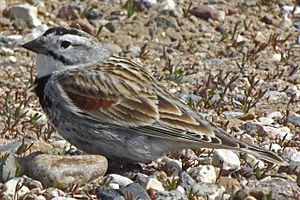Thick-billed longspur facts for kids
Quick facts for kids Thick-billed longspur |
|
|---|---|
 |
|
| Conservation status | |
| Scientific classification | |
| Genus: |
Rhynchophanes
|
| Species: |
mccownii
|
 |
|
The thick-billed longspur (Rhynchophanes mccownii) is a small bird that finds its food on the ground. It belongs to a bird family called Calcariidae. This family also includes other longspurs and snow buntings. You can find this bird in North America. It is the only species in its group, known as the genus Rhynchophanes.
Contents
Understanding the Thick-billed Longspur's Name
This bird was first described in 1851 by an American bird expert, George Newbold Lawrence. He named it Calcarius mccownii. Later, in 1858, it was moved to its own group, Rhynchophanes. This was because of its unique bill size and short spur. For a while, it was put back into the Calcarius group. This happened after a mixed-breed bird was found. That bird was a mix of this species and the chestnut-collared longspur.
However, a study in 2003 looked at the bird's genes. It found that the thick-billed longspur was actually more like snow buntings. It was less like the other longspurs. So, it was placed back into its own genus, Rhynchophanes.
Why the Name Changed: From McCown's to Thick-billed
The name "McCown" came from Captain John P. McCown. He was an American army officer. In 1851, he collected the bird that helped scientists describe the species. Captain McCown later fought for the Confederacy. This led to some debate starting in 2018. People saw it as similar to the removal of Confederate memorials.
The push to change the bird's name grew stronger. This happened after events like the George Floyd protests and Black Birders Week. Black Birder's Week itself was a response to the Central Park birdwatching incident.
Because of this, the American Ornithological Society no longer uses "McCown's longspur." They now call it the "thick-billed longspur." This new name is a direct translation of its genus name, Rhynchophanes. Other bird groups, like the International Ornithological Congress, are also likely to follow this name change soon.
What Does the Thick-billed Longspur Look Like?
Thick-billed longspurs are about 15 centimeters (6 inches) long. They weigh around 25 grams (less than an ounce). Their wingspan is about 28 centimeters (11 inches). They have a large bill shaped like a cone. Their back has streaks, and their shoulder is a rust color. Their tail is white with a dark tip.
During the breeding season, the male bird looks different. He has a white throat and belly. His face and the back of his neck are gray. He also has a black crown on his head. At other times of the year, these birds are mostly plain brown. Their bills are pink.
Where Do Thick-billed Longspurs Live?
Thick-billed longspurs build their nests in shortgrass prairies. These areas are in the northwestern Great Plains states of the U.S. and the southern Prairie Provinces of Canada. When winter comes, they mostly fly to Texas and northern Mexico. Sometimes, they are seen in other parts of North America by accident.
Thick-billed Longspur Behavior and Life Cycle
The male thick-billed longspur makes a special tinkling song. He often sings it while flying. Their calls also include a dry rattling sound.
Nesting and Raising Young
These birds build their nests in a shallow dip on the ground. The eggs are kept warm for about 12 days. Both parent birds help feed their young. The young birds, called fledglings, leave the nest about 10 days after hatching. At this point, they cannot fly very well yet.
Outside of the breeding season, thick-billed longspurs gather in groups. Sometimes, they join other bird species. These can include the Lapland longspur and the horned lark.
What Do They Eat?
Their diet includes both seeds and insects.
Conservation Status: Protecting the Thick-billed Longspur
The number of thick-billed longspurs has gone down since the early 1900s. Their living areas have also shrunk. This is probably because they are losing their natural homes, called habitat loss.
See also
 In Spanish: Escribano de McCown para niños
In Spanish: Escribano de McCown para niños


